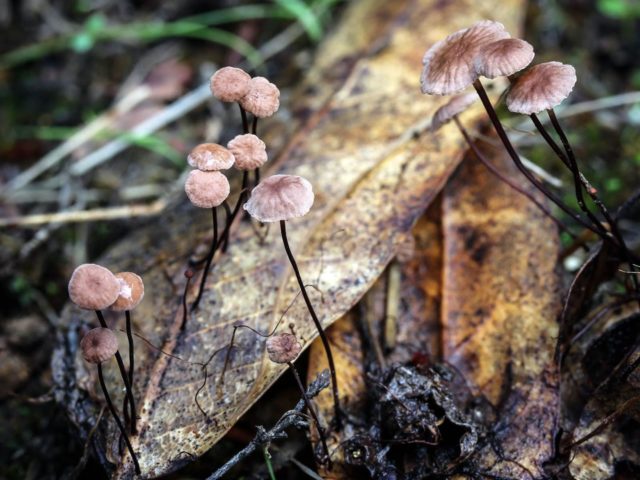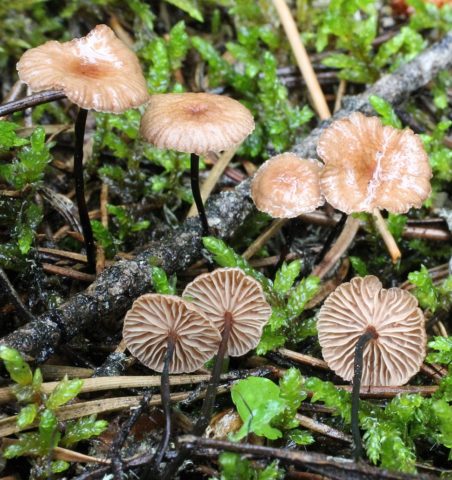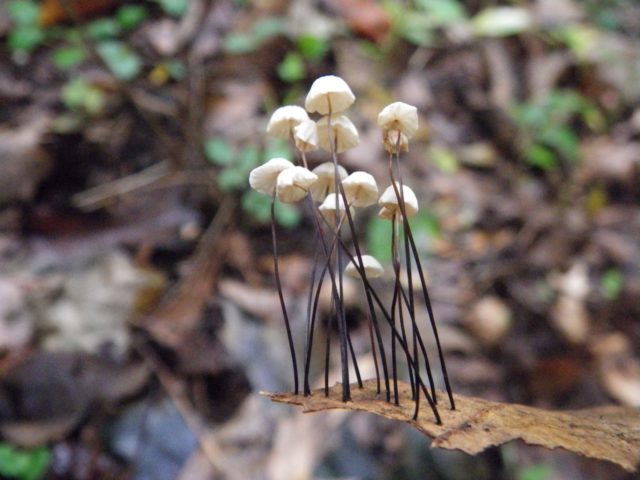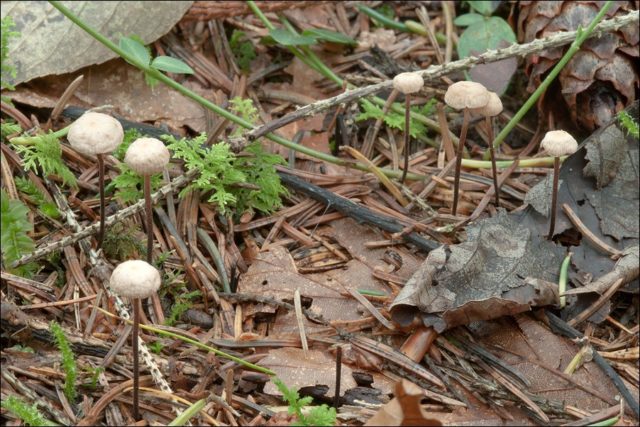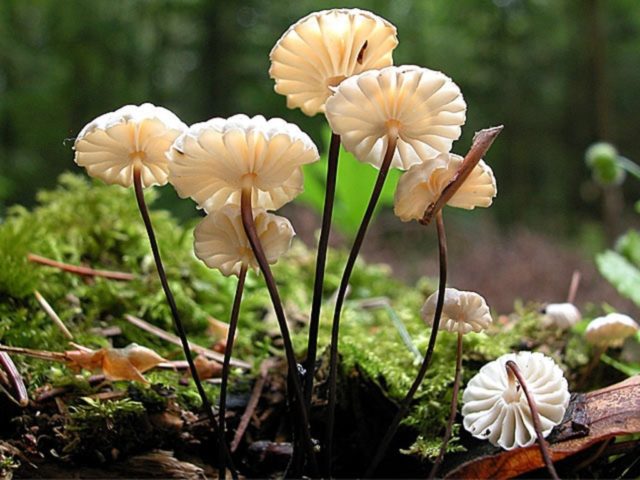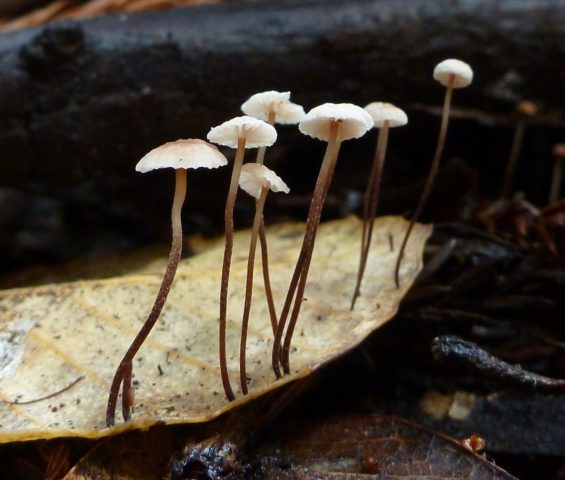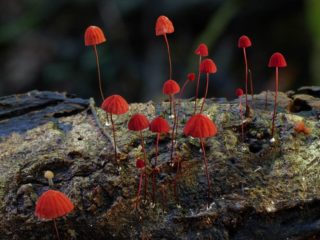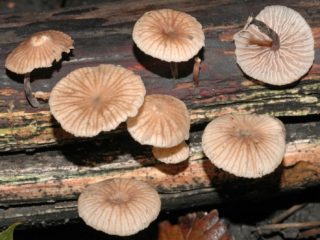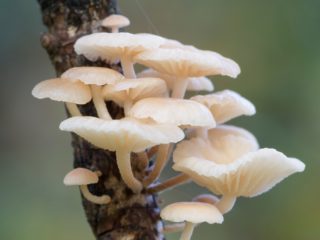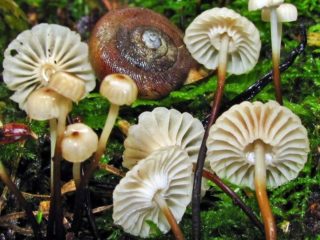Content
Negnium stamen is an inedible mushroom belonging to the Negnium family and the genus of the same name. Other names are bristle-legged garlic, stamen-shaped.
What does stamen non-stamen look like
Garlic bristle-legged - a small lamellar mushroom on a thin stem.
Description of the hat
The diameter of the cap is from 0.4 to 1 cm, the maximum is up to 1.5 cm. At first, it is convex, hemispherical or in the form of a blunt cone. It gradually becomes flattened, depressed in the center. The surface is covered with radial grooves, more pronounced towards the edges.
A young non-stamen stamen has a whitish cap. As it ripens, it acquires a gray-cream, yellowish-brownish-brown, pinkish or gray-brown color. In the center, it is darker - chocolate brown or dark pinkish brown.
The plates are rare, narrow, adherent to the stem, sometimes intertwining. They do not form a ring around the leg, but descend along it, while in other non-nippers they form the so-called collarium and grow to it. The plates are the same color as the cap - pinkish-yellow or pinkish-brown.
The spore powder of stamen nonnium is white.
Spores are almond-shaped, ellipsoidal, or teardrop-shaped.
The flesh is thin, the color of the cap. The smell is not expressed, according to some sources - unpleasant.
Leg description
Height - from 2 to 5 cm, diameter - up to 1 mm. The leg is thin, threadlike, shiny, rigid. Its surface is covered with scales. Color from reddish-brown to black, whitish at the top.
Where and how it grows
The stamen grass grows in large colonies, consisting of a huge number of specimens. He settles mainly on fallen small twigs of coniferous trees (he prefers spruce, fir, pine, larch). It grows on dry oak and birch leaves, the remains of shrubs (crowberry, heather), some herbaceous plants (northern linnea, cotton grass). Comes across wastelands, sand dunes. It can be found on old wood, mostly coniferous. Sometimes it appears on living plants, entwining them with plexuses of mushroom filaments - rhizomorphs.
Forms thick and dense weaves of hyphae. They occupy a free substrate, making it suitable for other plants.
After warm, heavy rains in places completely covered with old needles, impressive colonies of stamen garlic appear.
The fruiting time of the mushroom is from June to September. In Russia, it is distributed throughout the forest zone.
Is the mushroom edible or not
The stamen grass is considered an inedible mushroom. There is no information about its toxicity, it is possible that it does not contain toxins.
Doubles and their differences
The stamen grass bears a resemblance to the micromphale of the cleft-toothed. The main differences of the latter are the sharp unpleasant smell of rotten cabbage and the felt structure of the leg.
Another similar species is the wheel-shaped nonnium. Refers to inedible, presumably not poisonous. It is small but somewhat large in size. The cap is from 0.5 to 1.5 cm in diameter, a very thin leg 8 cm high. It has a similar shape of the cap (first in the form of a hemisphere, then prostrate). At a young age it is completely white, in mature it is yellowish-grayish. The plates are adherent, but not to the stem, but to a small ring around it - the collarium. The pulp has a pungent odor. Occurs in areas with high humidity, grows in large groups. It settles on a litter of needles and leaves, on fallen trees.
The stamen garlic can be confused with Gymnopus quercophilus. The main difference is the place of growth. Gymnopus can be found exclusively on the leaves of broad-leaved species such as chestnut, oak, maple, beech. The mycelium of this fungus makes the color of the substrate on which it grows pale yellow.
Conclusion
The stamen grass is a fairly common very small and thin mushroom that does not represent nutritional value. It is believed to have medicinal properties. In China, it is grown artificially and used as an analgesic, antigenic and restorative agent. The extract and dried specimens are used. Rhizomorphs - long plexuses of hyphae (mushroom filaments) - are used to prepare the preparations.
